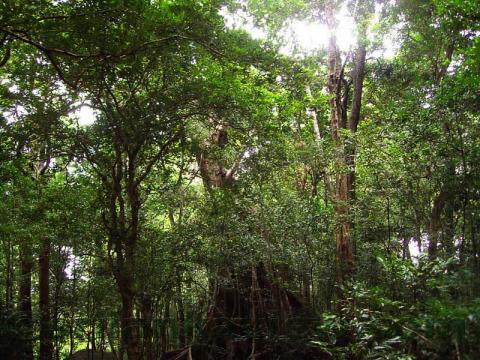Tropical dry monsoon (mixed evergreen) forest
Dry mixed evergreen forests are the most extensive type of forests and are found in the dry zone. They are characterized by monsoon forests and thorn scrub lands. Evergreen forests represent the tropical dry forests covering a major part of the dry zone adding up to 16.8% of the land area except for the southwestern quarter, the central mountain range, and the Jaffna Peninsula in the extreme north. Dry mixed evergreens receive about 1,500-2,000 mm of annual rainfall in December to March northeast monsoon period but are mostly dry during the rest of the year. The strong seasonality in rainfall has prompted these forests to be referred to as monsoonal forests.
Topographically, the ecoregion is flat, except for scattered inselbergs. Inselbergs are rocky outcrops in a flat landscape. The evergreen dry forests have no canopy formation and trees seldom exceed 20m in height. Although deciduous species exist in these forests their evergreen character is maintained by a few widespread species. Deciduous is where the leaves fall off periodically and grow again. These forests are dominated by Palu (Manilkara hexandra) (Sinhala – Palu), Satin (Chloroxylon sweitenia) (Sinhala – Burutha), Drypetes sepiaria, Feronia limonia, Vitex altissima, Syzygium spp., Drypetes sepiaria and Chukrasia tabularis.
The scrub and regenerating forests are characterized by Bauhinia racemosa, Pterospermum suberifolium, Cassia fistula and Dichrostachys cineria. Acacia thorn scrub grows in disturbed areas. Ritigala, the isolated hill in central Sri Lanka, is a hotspot of endemic species within this ecoregion with several endemic plants such as Madhuca clavata.

Ritigala
The appearance of these forests differs seasonally and depicts an annual cyclical variation in floristic diversity of the ground vegetation. Leaves of plant species here are small, without drip tips; many have compound leaves. The tree trunks branch lower down and show no buttresses, compared with those in rainforests. Epiphytes and lianas are relatively sparse in this forest type. A significant proportion of this flora is similar to that of India, and only about 13 % of the tree species are endemic to Sri Lanka. These forests are rich in quality hardwood species suitable for sawn timber and for this reason and for agricultural expansion, they have been clear-felled in the past and are now mostly restricted to protected areas.
Compared with Sri Lanka’s rain forests, these forests do not have very high levels of endemism. Nevertheless, they harbour one of Asia’s largest elephant populations, estimated at 3,500 to 4,000 animals and many large mammals. Several of the ecoregion’s mammals are also listed as threatened; elephant (Elephas maximus), the Sri Lankan leopard, the vulnerable Sloth Bear (Melursus ursinus), Purple-faced Leaf Monkey and Slender Loris. The richness of bird life is greater, with 270 species, which include several endemic species namely Red-faced Malkoha (Phaenicophaeus pyrrhocephalus), Ceylon Spur Fowl, Jungle Fowl, Brown-capped Babbler (Pelleorneum fuscocapillum) and Ceylon Hanging Parrot or Ceylon Lorikeet (Loriculus beryllinus).

